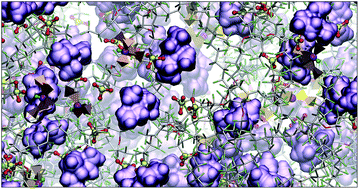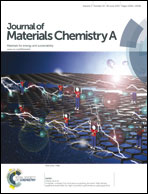Ammonium-based protic ionic liquid doped Nafion membranes as anhydrous fuel cell electrolytes†
Abstract
Polymer electrolyte membranes doped with Protic Ionic Liquids (PILs) can serve as promising materials for anhydrous proton conduction. In the present study, molecular dynamics simulations are performed to characterize the structure and dynamics of a diethylmethylammonium triflate ([dema][TfO]) PIL doped Nafion membrane at various PIL doping and temperatures. The polymer membrane PIL interface structure shows that the hydrogen bonding interactions predominantly exist between the acidic site (N–H) of the ammonium cation and SO3− group of the [TfO−] anion or Nafion. The distribution of the SO3− group (of the [TfO−] anion or Nafion) around the ammonium cation increases with PIL concentration. The existence of weak hydrogen bonding interactions between the alkyl hydrogen atoms of the [dema+] and the SO3− group of Nafion remains unaffected by the PIL concentration. An increase in the PIL doping level and temperature results in faster diffusion (higher ionic conductivity) which is in qualitative agreement with experiments.


 Please wait while we load your content...
Please wait while we load your content...